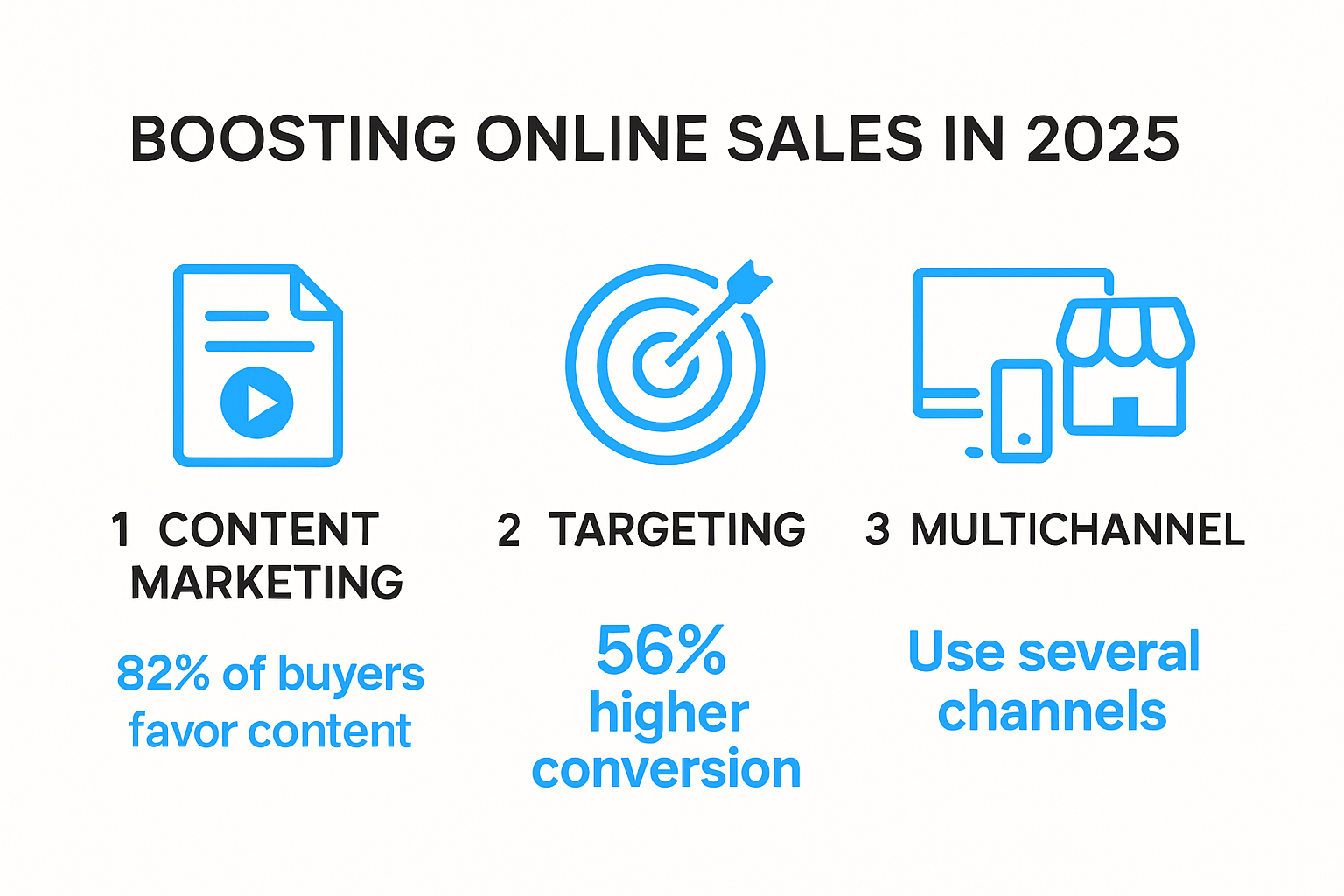Online shopping has exploded and businesses are fighting for a slice of the action. You might think building a flashy website is enough to cash in on the trend but the numbers say otherwise. A whopping 88% of online shoppers never return after a bad website experience. This flips the script because it means clever design, personal touches, and sharp tech are what actually drive sales in 2025.
Table of Contents
- Optimising Your Online Storefront For Growth
- Leveraging Digital Marketing To Attract Buyers
- Using Technology To Improve Customer Experience
- Implementing Data-Driven Sales Strategies
Quick Summary
| Takeaway | Explanation |
|---|---|
| Focus on User-Centric Design | Prioritise intuitive navigation and responsive design to enhance user experience and boost conversions. |
| Implement Personalisation Strategies | Use customer data to personalise interactions, fostering trust and increasing potential sales. |
| Invest in Multichannel Marketing | Employ various digital channels to maintain brand visibility and reach potential customers effectively. |
| Leverage AI for Customer Engagement | Integrate AI technologies to enhance customer experiences through predictive support and tailored recommendations. |
| Utilise Data-Driven Sales Techniques | Employ advanced analytics to derive insights that optimise sales strategies and predict customer behaviours. |
Optimising Your Online Storefront for Growth
Building a successful online storefront requires more than just creating a website. It demands a strategic approach that transforms your digital presence into a powerful sales engine. Modern businesses need to understand that their online platform is not just a digital brochure but a dynamic marketplace designed to attract, engage, and convert potential customers.
Creating a User-Centric Design
The foundation of an effective online storefront lies in its user experience. Learn how to enhance your website’s performance by prioritising intuitive navigation and seamless interaction. According to Forrester Research, 88% of online shoppers are less likely to return to a website after a poor user experience. This means every aspect of your digital storefront must be meticulously crafted.
Key design elements that drive conversion include:
- Clear Visual Hierarchy: Guide users’ attention to critical purchase points
- Responsive Mobile Design: Ensure smooth functionality across all devices
- Fast Loading Speeds: Reduce bounce rates by optimising page performance
Below is a table summarising essential user-centric design elements and their benefits for online storefronts.
| Design Element | Purpose/Benefit |
|---|---|
| Clear Visual Hierarchy | Directs user attention to key actions and purchase points |
| Responsive Mobile Design | Ensures usability and accessibility across devices |
| Fast Loading Speeds | Reduces bounce rates and keeps users engaged |
| Intuitive Navigation | Simplifies user journey, increasing conversions |
| Seamless Interaction | Creates a frictionless experience for the customer |
Personalisation and Trust Building
Customers want more than generic interactions. They seek personalised experiences that make them feel understood. Gartner’s digital marketing research reveals that businesses implementing advanced personalisation strategies can increase their profits by up to 15%.
To build trust and encourage purchases, implement strategies such as:
- Dynamic Product Recommendations: Use customer browsing history to suggest relevant items
- Social Proof Elements: Display customer reviews and testimonials prominently
- Transparent Pricing and Policies: Clearly communicate shipping, returns, and guarantee information
Converting Visitors into Customers
Transforming website visitors into paying customers requires a holistic approach. Every element of your online storefront should be strategically designed to reduce friction and encourage purchase decisions. This includes streamlining checkout processes, offering multiple payment options, and providing clear, compelling product descriptions.
Implement conversion-focused techniques like:
- Urgency Triggers: Limited-time offers and stock availability indicators
- Simplified Checkout: Reduce form fields and offer guest checkout options
- Secure Payment Gateways: Display trust badges and use recognised payment platforms
Successful online storefronts in 2025 understand that digital commerce is about creating meaningful connections. By focusing on user experience, personalisation, and strategic conversion tactics, businesses can transform their websites from passive platforms to active sales generators.
Remember, your online storefront is your 24/7 digital sales representative. Invest in its design, functionality, and user experience to unlock your business’s full online potential.
Leveraging Digital Marketing to Attract Buyers

In the rapidly evolving digital marketplace, attracting buyers requires a sophisticated and targeted approach to marketing. Businesses must move beyond traditional advertising and embrace strategic digital marketing techniques that connect with potential customers precisely where they spend their time online.
Targeted Content Marketing
Explore our comprehensive digital marketing strategies that drive meaningful engagement. According to Content Marketing Institute, businesses that prioritise content marketing see conversion rates six times higher than those using traditional marketing methods.
Effective content marketing strategies include:
- Value-Driven Blog Posts: Create in-depth, problem-solving content that addresses customer pain points
- Video Content: Develop engaging tutorials, product demonstrations, and customer testimonial videos
- Interactive Infographics: Use visually compelling data presentations to explain complex concepts
Precision Targeting and Retargeting
HubSpot’s marketing research reveals that personalised marketing campaigns can increase conversion rates by up to 202%. Modern digital marketing is about understanding your audience at a granular level and delivering hyper-relevant messaging.
Key targeting techniques encompass:
- Audience Segmentation: Divide potential customers into specific demographic and behavioural groups
- Behavioural Retargeting: Create ads that follow interested customers across different digital platforms
- Lookalike Audience Creation: Develop marketing campaigns targeting individuals similar to your existing customer base
Multichannel Marketing Approach
Successful digital marketing in 2025 demands a holistic strategy that seamlessly integrates multiple channels. This approach ensures your brand maintains consistent visibility and provides multiple touchpoints for potential customers.
Comprehensive multichannel strategies involve:
- Social Media Advertising: Develop platform-specific campaigns that resonate with different audience segments
- Search Engine Marketing: Optimise paid and organic search strategies to capture high-intent customers
- Email Marketing Automation: Create personalised email journeys that nurture leads through the sales funnel
The digital marketing landscape continues to evolve rapidly. Businesses that remain agile, data-driven, and customer-centric will successfully attract and convert buyers in an increasingly competitive online environment.
Remember, digital marketing is not about reaching the most people but about reaching the right people with the most compelling message at the perfect moment.
Using Technology to Improve Customer Experience
In the digital era, customer experience has become the primary differentiator for businesses seeking to stand out in a crowded marketplace. Technology offers unprecedented opportunities to create personalised, seamless, and engaging interactions that transform how customers perceive and interact with brands.
AI-Powered Personalisation
Discover innovative customer experience strategies that leverage cutting-edge technology. According to research from Hungary’s consumer technology study, trust and perceived usefulness are critical factors in consumer acceptance of technological innovations. Artificial intelligence enables businesses to create hyper-personalised experiences that go beyond generic interactions.
Key AI-driven personalisation techniques include:
- Intelligent Recommendation Engines: Analyse customer behaviour to suggest precisely tailored products
- Predictive Customer Support: Anticipate customer needs before they arise
- Dynamic Pricing Strategies: Offer personalised pricing based on individual customer profiles
Below is a table outlining innovative technologies and their impact on customer experience as discussed in this section.
| Technology | Key Capability | Customer Benefit |
|---|---|---|
| AI Recommendation Engines | Suggest tailored products | Increases relevance, boosts sales |
| Predictive Customer Support | Anticipate and resolve issues early | Enhances trust, reduces friction |
| Dynamic Pricing | Adjust prices based on user profiles | Offers personalization, improves satisfaction |
| Emotional Intelligence Chatbots | Recognize and adapt to user mood | Builds rapport, improves engagement |
| Augmented Reality (AR) Fitting | Virtual try-on and product visualization | Increases confidence, reduces returns |
Conversational Technology and Customer Engagement
Research on chatbot interactions reveals that consumers respond positively to technologies that demonstrate empathy and friendliness. Modern chatbots are no longer simple response machines but sophisticated communication tools that can significantly enhance customer satisfaction.
Advanced conversational technologies offer:
- Contextual Understanding: Chatbots that comprehend nuanced customer queries
- Emotional Intelligence: Systems that adapt communication style based on customer mood
- Multilingual Support: Breaking down language barriers in customer interactions
Immersive Shopping Experiences
Augmented reality is revolutionising how customers interact with products online. Conceptual research on AR shopping applications demonstrates that immersive technologies can dramatically enhance customer satisfaction and purchase behaviour.
Cutting-edge immersive technologies include:
- Virtual Product Trials: Allow customers to visualise products in their own environment
- Interactive 3D Product Models: Provide comprehensive product exploration
- Augmented Reality Fitting Rooms: Enable precise sizing and style matching
Technology is transforming customer experience from a transactional interaction to a deeply personalised journey. By embracing these innovative approaches, businesses can create meaningful connections that extend far beyond traditional customer service models.
The future of customer experience is not about technology replacing human interaction but about using technology to make interactions more human, intuitive, and genuinely helpful.
Implementing Data-Driven Sales Strategies
In the rapidly evolving digital marketplace, businesses must transition from traditional sales approaches to sophisticated, data-driven strategies that leverage advanced analytics and machine learning technologies. The future of sales is not about intuition but about precise, actionable insights derived from comprehensive data analysis.
Predictive Sales Analytics
Explore advanced sales optimization techniques that transform raw data into strategic advantage. According to Gartner’s Future of Sales 2025 report, 60% of B2B sales organizations will transition to data-driven selling models, emphasising digital and self-service channels.
Key predictive analytics strategies include:
- Customer Behaviour Forecasting: Anticipate purchasing patterns and potential churn risks
- Revenue Prediction Models: Develop accurate sales projections using historical and real-time data
- Opportunity Scoring: Prioritise leads based on comprehensive likelihood-to-purchase algorithms
Causal Machine Learning in Sales Optimization
Cutting-edge research from LinkedIn demonstrates a revolutionary three-layered approach to sales optimization: prediction using causal machine learning, constraint optimization, and generative AI feedback loops. This sophisticated methodology goes beyond traditional sales strategies by understanding complex cause-and-effect relationships in customer interactions.
Advanced machine learning techniques involve:
- Contextual Bandits: Dynamically adjust sales strategies based on real-time customer interactions
- Predictive Intervention Design: Create targeted sales approaches for specific customer segments
- Complex Decision Modeling: Understand and predict multi-factor sales outcomes
Strategic Marketing Intervention Analysis
Marketing intervention research reveals the power of causal machine learning in evaluating sales strategies. By applying sophisticated algorithms, businesses can precisely measure the impact of marketing campaigns and sales interventions across different customer groups.
Strategic intervention techniques include:
- Coupon Campaign Optimization: Develop targeted discount strategies with measurable impact
- Segment-Specific Marketing: Design precisely tailored approaches for different customer groups
- Performance Attribution: Accurately measure the effectiveness of individual marketing tactics
Data-driven sales strategies represent more than technological innovation they signify a fundamental shift in how businesses understand and engage with customers. By embracing these advanced analytical approaches, organisations can create more responsive, intelligent, and effective sales ecosystems.
The future of sales is not about collecting data but about transforming that data into meaningful, actionable strategies that drive genuine business growth.

Frequently Asked Questions
How can I improve the user experience on my online store?
To enhance user experience, focus on user-centric design elements such as intuitive navigation, responsive mobile design, fast loading speeds, and clear visual hierarchies. These features help reduce bounce rates and increase conversion rates.
What are effective personalisation strategies for boosting online sales?
Effective personalisation strategies include dynamic product recommendations based on browsing history, showcasing customer reviews for social proof, and clearly communicating pricing and policies to build trust with customers.
How can I leverage digital marketing to attract more customers?
Utilise targeted content marketing, precision targeting and retargeting techniques, and implement a multichannel marketing approach. This helps maintain brand visibility and connects with potential customers through various platforms.
What role does technology play in enhancing customer experience?
Technology enhances customer experience through AI-powered personalisation, conversational technology for customer engagement, and immersive shopping experiences such as augmented reality. These innovations create more meaningful connections between customers and brands.
Ready to Transform Browsers Into Loyal Customers?
Struggling to turn website visitors into real buyers despite investing in digital marketing and a modern storefront? The article highlighted how a poor user experience or lack of personalisation can cause almost nine out of ten shoppers to walk away without a second look. The good news is these challenges are fixable with the right team and tools. CloudFusion specialises in designing tailored digital solutions that resolve common pain points discussed in this guide. We focus on user-centric web design, seamless mobile experiences, and strategic branding to make every online interaction count. Our expertise covers not only website performance but also data-driven digital marketing and scalable cloud infrastructure.
Take the next step towards real growth in 2025. Request your personalised web design and development quotation today or visit our main site to discover how we can help your business thrive online. Secure your competitive edge while top strategies still deliver results. Let us help you build smarter solutions now.








